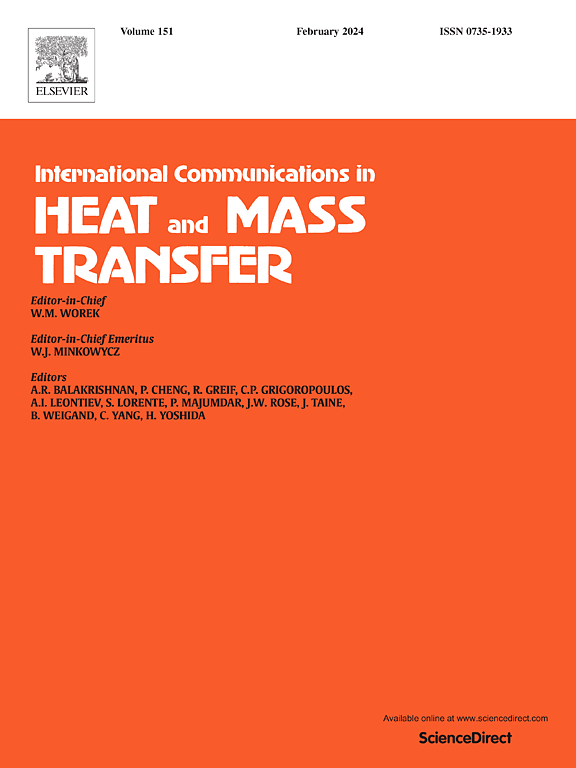Convective flow between inclined plates using Cartesian coordinate system
IF 6.4
2区 工程技术
Q1 MECHANICS
International Communications in Heat and Mass Transfer
Pub Date : 2025-05-30
DOI:10.1016/j.icheatmasstransfer.2025.109143
引用次数: 0
Abstract
This paper examines the convective transport of thermal energy in flow, maintained between inclined, rectangular, and heated walls. The convection process and non-uniform stream velocity at the centre of these particular channels have developed the fluid motion, whereas, the diffusion of heat and behavior of flow in the whole channel is examined by considering the different thermal and dynamical situations in the flow domain. Both walls of this channel are heated and have uniform temperatures, however, temperature distribution is significantly changed in the flow regime with the variation of thermal and geometrical characteristics. The problem is formulated in terms of two-dimensional continuity and Navier-Stokes equations in a rectangular coordinate system. The leading equations, i.e., PDEs and the associated boundary condition (BCs), are converted into a set of ODEs with the help of proper similarity transformation. Asymptotic (perturbation) and numerical (bvp4c package) procedures are employed to solve the resulting problem. The perturbation technique is applicable for small parameter values and these ranges of dimensionless numbers meet the criteria of convergent series solutions for the problem in hand, whereas, the numerical method provides solutions across a widespread range of governing constraints in the problem. Remember that the final equations are equipped with a slope for the upper wall of the channel, Reynolds number, Prandtl number, and two components of Grashof number. To the best of the author's knowledge, a self-similar solution of the forced convective flow in this particular structure and the specified BCs has not been studied using the Cartesian coordinate system. The impacts of various parameters have been noted on the graphs for velocity, temperature distribution, skin friction and the rate of heat transfer coefficient. The temperature profile is effectively enhanced particularly for gases and liquid flow within a converging (diverging) channel with the change of various parameters. However, the temperature profiles decrease for certain parameters, such as:
- •water flow in a converging channel when the slope of the wall () lies in the range ,
- •flow of water and air in a converging channel when the Grashof number is varied for assisting and opposing flow.
斜板间的对流流动采用直角坐标系
本文考察了流动中热能的对流输送,维持在倾斜、矩形和加热壁面之间。这些特殊通道中心的对流过程和非均匀流速度发展了流体运动,而通过考虑流域中不同的热动力情况来研究整个通道内的热扩散和流动行为。该通道两侧壁面均受热且温度均匀,但随着热特性和几何特性的变化,流态温度分布发生显著变化。该问题是用二维连续性和直角坐标系下的Navier-Stokes方程来表述的。通过适当的相似变换,将前导方程即偏微分方程及其边界条件转化为一组偏微分方程。采用渐近(摄动)和数值(bvp4c包)程序求解结果问题。摄动技术适用于小参数值,这些无量纲数的范围满足当前问题的收敛级数解的标准,而数值方法提供了问题中广泛的控制约束范围的解。记住,最后的方程中包含了通道上壁的斜率,雷诺数,普朗特数,以及两个格拉什夫数的分量。就笔者所知,还没有人用笛卡尔坐标系研究过这种特殊结构和特定bc的强迫对流的自相似解。在速度图、温度分布图、表面摩擦图和换热系数图上记录了各种参数的影响。温度分布随着各种参数的变化而有效地增强,特别是在收敛(发散)通道内的气体和液体流动。然而,在某些参数下,温度分布会减小,例如:•当壁面坡度(m)在0<;m<;0.33范围内时,水流在会聚通道内的流动;•当改变格拉什夫数时,水流和空气在会聚通道内的流动。
本文章由计算机程序翻译,如有差异,请以英文原文为准。
求助全文
约1分钟内获得全文
求助全文
来源期刊
CiteScore
11.00
自引率
10.00%
发文量
648
审稿时长
32 days
期刊介绍:
International Communications in Heat and Mass Transfer serves as a world forum for the rapid dissemination of new ideas, new measurement techniques, preliminary findings of ongoing investigations, discussions, and criticisms in the field of heat and mass transfer. Two types of manuscript will be considered for publication: communications (short reports of new work or discussions of work which has already been published) and summaries (abstracts of reports, theses or manuscripts which are too long for publication in full). Together with its companion publication, International Journal of Heat and Mass Transfer, with which it shares the same Board of Editors, this journal is read by research workers and engineers throughout the world.

 求助内容:
求助内容: 应助结果提醒方式:
应助结果提醒方式:


